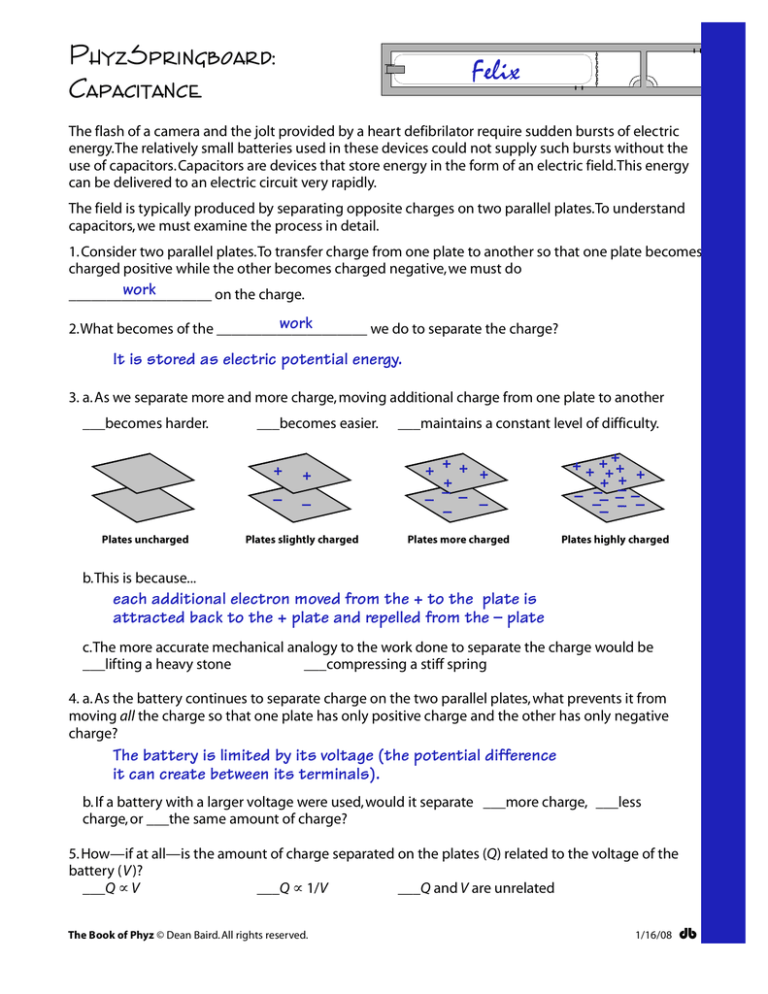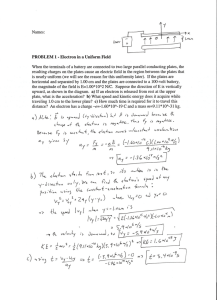
PhyzSpringboard:
Capacitance
Felix
The flash of a camera and the jolt provided by a heart defibrilator require sudden bursts of electric
energy.The relatively small batteries used in these devices could not supply such bursts without the
use of capacitors.Capacitors are devices that store energy in the form of an electric field.This energy
can be delivered to an electric circuit very rapidly.
The field is typically produced by separating opposite charges on two parallel plates.To understand
capacitors, we must examine the process in detail.
1. Consider two parallel plates.To transfer charge from one plate to another so that one plate becomes
charged positive while the other becomes charged negative,we must do
work
___________________
on the charge.
work
2.What becomes of the ____________________
we do to separate the charge?
It is stored as electric potential energy.
3. a.As we separate more and more charge, moving additional charge from one plate to another
___becomes harder.
Plates uncharged
___becomes easier.
+
+
–
–
Plates slightly charged
___maintains a constant level of difficulty.
+ + + +
+
– – – –
–
Plates more charged
+ + ++++ +
+ +
–
– –– –– ––
– –
Plates highly charged
b.This is because...
each additional electron moved from the + to the plate is
attracted back to the + plate and repelled from the – plate
c.The more accurate mechanical analogy to the work done to separate the charge would be
___lifting a heavy stone
___compressing a stiff spring
4. a.As the battery continues to separate charge on the two parallel plates, what prevents it from
moving all the charge so that one plate has only positive charge and the other has only negative
charge?
The battery is limited by its voltage (the potential difference
it can create between its terminals).
b. If a battery with a larger voltage were used,would it separate ___more charge, ___less
charge, or ___the same amount of charge?
5. How—if at all—is the amount of charge separated on the plates (Q) related to the voltage of the
battery (V )?
___Q ∝ V
___Q ∝ 1/V
___Q and V are unrelated
The Book of Phyz © Dean Baird. All rights reserved.
1/16/08
db
6. Not all parallel plates are identical. Some plates are bigger, some
are smaller; some are closer together, some are farther apart.
Suppose a battery connected to one set of plates separates a large
amount of charge but the same battery connected to another set of
plates separates only a small amount of charge.
The plates on which the large charge separation occurred have
___a higher capacity (high capacitance) than the other plates.
___a lower capacity (low capacitance) than the other plates.
7.a.Which expression best represents capacitance,denoted with
the symbol C?
___C = QV
___C = Q/V
___C = V/Q
b.Is this expression consistent with the proportionality selected
in question 5 above? If so,rewrite the proportionality as an
equation.
Q ∝ V => V = Q/C => Q = CV
c.What are the SI units of capacitance and what is the
abbreviation for these units?
C/V = F
d. A pair of plates with a high capacitance is one that can
___hold a great quantity of charge at a high potential.
___hold a great quantity of charge at a low potential.
___hold a small quantity of charge at a low potential.
8. Suppose a battery were used to separate charge on two parallel
plates.The battery has moved all the charge it can.Sketch the forces
acting on the negative charge on the right end of the lower plate.
a.What effect do these forces have on the two plates?
+
+
+
–
–
–
attraction
b.What effect do these forces have on the neighboring charges?
repulsion
c.Which forces would be reduced if the plates were moved
farther apart? (Check all that apply.)
___Those that cause the plate charges to attract.
___Those that cause the plate charges to repel.
CAPACITOR CHARACTERISTICS
9.a.What will be the effect of increasing the area of the plates?
___More charge can be stored at the same potential.
___Less charge can be stored at the same potential.
___The same amount of charge can be stored.
b.Why? Discuss the forces involved.
neighboring charges repel; more area means
the same number of charges would have more
space.
The Book of Phyz © Dean Baird. All rights reserved.
1/16/08
db
c.Determine the amount of charge that can be separated in
terms of the potential difference of the battery, the area of
the plates, and the distance between the plates.Hints:
consider the relationship between the voltage, electric field,
and distance, then consider the relationship between the
uniform electric field, charge, area, and distance.
V = Ed
E = 4 kQ/A
V = 4 kQd/A
Q = VA/4 kd
d.Examine the equation from part c above.With constant
potential and distance and increased plate area,
___more charge can be stored.
___less charge can be stored.
___the same amount of charge can be stored.
10. a.What will be the effect of increasing the distance between
the plates?
___More charge can be stored.
___Less charge can be stored.
___The same amount of charge can be stored.
b.Why? Discuss the forces involved.
The weakening of the attraction that keeps
charges in place.
c.Examine the equation from part c of number 9 above.With
constant voltage and area and increased plate separation,
___more charge can be stored.
___less charge can be stored.
___the same amount of charge can be stored.
d.Another way to increase the capacitance of a set of parallel
plates is to place a sheet of a dielectric (insulating) material
between the plates. But that’s a story for another course.
11. a. Summarize your findings regarding plate area and separation
distance.
___C ∝ Ad
___C ∝ A/d
___C ∝ d/A
b. Describe the characteristics of a high capacitance capacitor.
large surface area and small separation
distance.
c.A constant of proportionality, ε0, turns this proportionality
into an equation.The constant is called the permittivity of free
space. Rewrite the proportionality as an equation.
C = ε0A/d
The Book of Phyz © Dean Baird. All rights reserved.
1/16/08
db
ENERGY STORAGE
12. Suppose a variable voltage power supply were
used to charge a 1.0 F capacitor.What would happen
as the voltage was increased from 0 to 12 V?
a. Describe the result and plot it on the axes to
the right.
b.What is the area bounded by the plot?
i.Write an equation.
A = VQ/2
10
8
6
4
2
ii.Calculate the area.Don’t forget the units.
2
A = 12 V · 12 C / 2 = 72 J
4
6
8
10
Potential V (V)
c.What does that area represent?
Electric potential energy stored
d.Another capacitor is charged with a variable
voltage power supply. It yields the plot shown to
the right.
25
i.What is the capacitance of the capacitor?
20
Q/ V = Q/V = C = 3F
ii.How much electrical energy is stored in the
capacitor?
15
10
5
VQ/2 = 10 V · 30 C / 2 = 150 J
e. Use the expression from question 7 to write
two more independent forms of the equation
from part b above.
2
4
6
8
10
Potential V (V)
W = QV/2 = CV2/2 = Q2/2C
13. The capacitor’s charge (and stored energy) can be made available to an electric circuit,such as
one in an electronic flash or a heart defibrilator.The capacitor can deliver the charge and energy
faster than a battery can.A device that uses a great deal of energy in a short interval of time can best
be described as
___high voltage.
___high energy.
___high amperage.
___high wattage.
The Book of Phyz © Dean Baird. All rights reserved.
___high charge.
___high capacitance.
1/16/08
db



